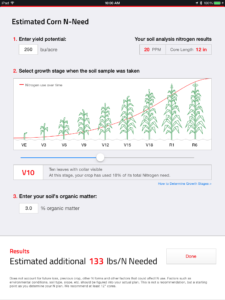Sidedress season has arrived in many parts of the Corn Belt. With frequent and significant rainfall, the decisions you make for nitrogen management will make a big impact on yield potential. Knowing where your nitrogen levels are in the field plays a key role in capturing that potential. 360 SOILSCAN allows you to get real-time, in-field soil nitrate readings in approximately five minutes so you can measure how much N is left and immediately adjust your sidedress application plan.
However, knowing how much N you have and how much N you need are two different things. To help farmers build an N application plan based on the soil nitrate results, we have added a new Corn Nitrogen Need Calculator in the 360 SOILSCAN App. If you have a 360 SOILSCAN, simply visit the App store and go to the Updates section to get the new software update.
After running the soil nitrate test, you now can access the Corn Nitrogen Need Calculator from either the Analyze or Results tab in the 360 SOILSCAN App. The calculator will automatically pre-populate the PPM reading and the sample core length from the analyzed sample of the selected cornfield. From this point, you will need to provide some additional information.
- Yield Potential. Use a number that you are comfortable with at that time.
- Crop Growth Stage. This input is critical in determining where the corn plant is in the N uptake cycle and can greatly affect the estimated N needs of your corn. If you need assistance determining the growth stage of your corn, follow the link located within the Corn Nitrogen Need Calculator.
- Soil Organic Matter. These numbers can change as you move throughout the field. Be sure to provide an accurate number, if possible, so you can get an accurate N need calculation.

Here are a few additional tips to get the most out of the 360 SOILSCAN App and Corn Nitrogen Need Calculator.
- Sample your soil early and often. Building an N recommendation based on a one-time sample can lead to the wrong rate of N, especially early in the growing season. Frequent soil nitrate tests early in the season will inform you on the rate at which nitrogen converts from ammonium to nitrate combined with mineralization and potential loss that has occurred. Each field is different so testing in each field, and even in multiple management zones, can provide results that are more accurate.
- Pay attention to crop stage. Corn N uptake rapidly increases between V8 and V10. Corn takes up only 25% of N prior to V10. Understanding N uptake by growth stage can help you determine when to sample more often and if more N is needed at that time.
- Sample prior to and after big rain events. Heavy rainfall can affect our nitrogen levels significantly. By testing prior to and after rainfall, you will gain a better understanding of nitrogen loss in your fields.
- Find a Home Base. Sampling can be a daunting task, especially when corn reaches the later vegetative stages. In each field, find an easy-to access spot that is a good representation of the entire field. Avoid headlands, and high and low areas in the field. Monitor the “Home Base” so you can understand where nitrate levels are without continually sampling the entire field. However, prior to sidedress applications, take additional samples in the field for a more accurate picture of your N needs throughout the field.
- Test even after the N application. Nitrogen is one of the highest input costs in corn production. Too much N left over can be costly, but not enough can negatively impact yields. Sampling during grain-fill stage can provide insight into where you may have needed more or less N. After grain-fill, look for areas of the field where corn has ear tip-back and corn that is filled out to the end. Sampling each area can help you make decisions about variable rate applications for the following season – because not every acre is the same.
The Corn Nitrogen Need Calculator is a helpful tool to provide guidance on N applications. Keep in mind that the number the calculator provides is not a recommendation, but rather a starting point for application since the Corn Nitrogen Need Calculator does not account for future N loss, previous crop, other N forms or factors that could affect N use. Additionally, consider environmental conditions, soil type, slope, etc. when making final N application plans.
Visit www.360yieldcenter.com/Nitrogen to see how you can build and adjust your N management plan.